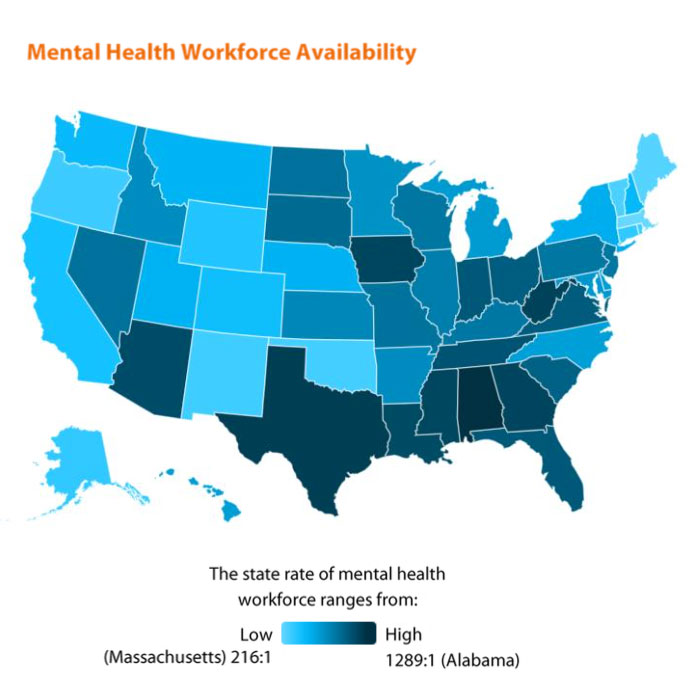Those who live in Alabama, Texas or West Virginia have vastly fewer mental health care providers to turn to for help and support than do Americans who live in Massachusetts, Maine or Washington, D.C. This discrepancy means that residents of the Southeast and other areas of the country often have more than four times less access to mental health care than their fellow Americans, according to Mental Health America (MHA).
The Virginia-based advocacy organization compiles a report annually on mental health indicators from across the United States, including statistics on access to mental health care, uninsured  citizens, rates of substance abuse, suicide indicators, youth depression and other factors. The document highlights the mental health disparities that occur across the nation.
citizens, rates of substance abuse, suicide indicators, youth depression and other factors. The document highlights the mental health disparities that occur across the nation.
“In Georgia or Florida, despite having lower percentages of individuals who need mental health services, those who have problems are likely to face more difficulty obtaining treatment as compared to other states,” MHA writes on page 16 of the report. “The opposite is true for states like Maine or Vermont, where there are more individuals with mental health and substance use issues and higher rates of access to care. Among states that rank the poorest, like Arizona, Idaho and Montana, there are comparatively more individuals needing mental health and substance use care, yet lower rates of access to mental health care.”
MHA’s nearly 60-page report, “The State of Mental Health in America 2016,” was released this fall and is available at mentalhealthamerica.net.
The report also contains an overall ranking of the 50 states and the District of Columbia, based on each state’s prevalence of mental illness and substance abuse versus the availability of mental health care.
Minnesota tops MHA’s 2016 rankings, followed by Massachusetts, Connecticut, Vermont and South Dakota.
At the bottom of the list are Washington state, Rhode Island, Nevada, Arizona and Oregon, with Oregon claiming the worst-ranked spot. The District of Columbia, the nation’s capital, is ranked 28th.
Last year, MHA’s overall top-ranked states were Massachusetts (now second), Vermont (now fourth) and Maine (now 17th). Conversely, last year’s worst-ranked states were Nevada (now 49th), Mississippi (now 35th) and Arizona (now 50th).

Among MHA’s key findings for 2016:
- Nationwide, there is an average of one mental health provider for every 566 people. Counselors were included in MHA’s definition of “mental health provider,” along with marriage and family therapists, psychiatrists, psychologists, licensed clinical social workers and advanced practice nurses who specialize in mental health care.
- At 250-to-1 (250 individuals for every one provider), Massachusetts, Maine and Vermont had the best ratio of mental health providers. Conversely, West Virginia, Texas and Alabama had the worst ratio of mental health providers, at 1,100-to-1.
- Across the United States, 64 percent of youth with depression do not receive any treatment. For youth with severe depression, just 22 percent receive any kind of consistent outpatient treatment (seven to 25 or more visits per year).
- Nationwide, approximately 1 out of 5 adults with a mental illness (20.1 percent) report that they are not able to get the treatment they need because of cost, insurance or other factors. This varies widely from state to state, from 11.8 percent in Hawaii and 15.9 percent in Montana to 27 percent in Utah and 27.3 percent in Idaho.
- Nationwide, 18.53 percent of adults reported suffering from a mental illness, which is a 0.4 percent increase over the prior year. For this statistic, MHA defined mental illness as “having a diagnosable mental, behavioral or emotional disorder, other than a developmental or substance use disorder,” including those with mild, moderate and serious mental illness. States with the lowest rates of mental illness were New Jersey (15.62 percent), North Dakota (16.35 percent), Maryland (16.55 percent), Illinois (16.68 percent) and Florida (16.91 percent), while Oregon (22.31 percent), Utah (22.30 percent), West Virginia (21.73 percent), Maine (21.36 percent) and Tennessee (20.52 percent) had the highest rates.
- Nationwide, 8.66 percent of adults report having a substance abuse or alcohol problem, a 0.2 percent increase over the prior year. Washington, D.C., was found to have the highest rate of adult dependence or abuse of illicit drugs or alcohol (14.29 percent), followed by Rhode Island (11.18), Montana (10.48), North Dakota (10.22) and Colorado (10.07). Conversely, Utah had the lowest rate of adult substance abuse (7.43 percent), followed by Georgia (7.53), Tennessee (7.63), New Jersey (7.84) and Alabama (7.9).
- Nationwide, 3.89 percent of adults reported having serious thoughts of suicide. Utah had the highest rate of adults with thoughts of suicide (4.84 percent), while Alabama, Florida and Maryland possessed the lowest rate at 3.51 percent.

****
Mental Health America’s The State of Mental Health in America 2016
For more details, or to see the report’s glossary or citations, visit mentalhealthamerica.net
****
Bethany Bray is a staff writer for Counseling Today. Contact her at bbray@counseling.org
Follow Counseling Today on Twitter @ACA_CTonline and on Facebook: facebook.com/CounselingToday
